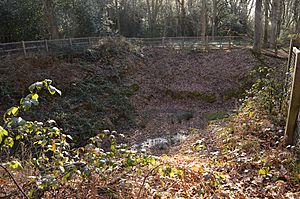Little Heath Pit facts for kids
| Site of Special Scientific Interest | |
 |
|
| Area of Search | Hertfordshire |
|---|---|
| Interest | Geological |
| Area | 0.3 hectares |
| Notification | 1986 |
| Location map | Magic Map |
Little Heath Pit is a special place in Hertfordshire, England. It's a small area, about the size of half a football field, that has been protected because of its unique rocks and history. It's known as a Site of Special Scientific Interest (SSSI) for its geology. The land is part of the Ashridge Estate, which is looked after by the National Trust.
Contents
A Journey Through Time: Little Heath Pit's Geology
Ancient Layers of Earth
The deepest rocks at Little Heath Pit are made of gravel. These gravel layers formed about 2.6 million years ago. This was during a time called the Pleistocene epoch, often known as the Ice Age. Back then, the North Sea covered a lot of what is now south-east England. Little Heath Pit was in an area where the land met the sea, like a beach or mudflat. Since that time, the Chiltern Hills have slowly risen about 170 metres!
Above this old gravel layer, you can find sand. Then, there's another layer of gravel that was laid down much later, about 20,000 years ago. This was during the coldest part of the Last Glacial Maximum, which was the peak of the last ice age. At that time, the area around Little Heath Pit was very cold, like the frozen plains of western Siberia today. It was a type of landscape called tundra.
A Scientific Puzzle
Scientists are very interested in Little Heath Pit because of what the rocks tell us. Experts from Natural England say the site is "controversial." This is because new digging at the pit shows that some of the gravel might have come from the sea, not from glaciers (huge sheets of ice) as was thought before. This new idea helps scientists understand more about how the landscape of England changed over millions of years.
How Big is Little Heath Pit?
The exact size of Little Heath Pit has been a bit confusing. In 2012, permission was given to put fences around the site. This was to protect it from badgers digging and to keep people safe from falling into the deep pit. At that time, the size was said to be about 360 square metres, which is quite small.
However, Natural England, the group that protects these special sites, says the area is actually 0.3 hectares. That's about 3,000 square metres. Their maps even show an even larger area of 1.2 hectares. So, while the protected area is clear, the exact size of the pit itself has been discussed.
Visiting Little Heath Pit
You can visit Little Heath Pit from Bullbeggars Lane. The area around the pit is covered in woods. You might also notice some deep holes in the ground, which local people call "dells." These "dells" are actually old pits where gravel was dug out. This gravel was used during World War I to make sandbags, which were important for soldiers on the front lines.

